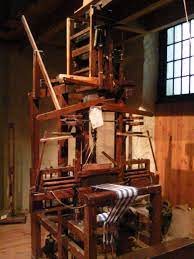Looms to Computers

September 30, 2022
The loom was the basis for today’s computers. One of the most innovative inventions of its time, the loom was a key component in the industrial revolution. It was the beginning of the era of machines. The loom allowed weaving production to increase significantly, and people went from making their own clothes to buying them in stores.
The Jacquard Loom was one of the first machines to use interchangeable punch cards to instruct a machine to perform automated tasks. The chain of punch cards direct the loom on how to create a series of unique textiles, or in other words, these punch cards compute the machine. Effectively, the time-consuming job of weaving was replaced by this innovation.
The cards determined which warp threads should be lifted so that the weft thread could pass underneath them when fed into the Jacquard mechanism, which was mounted to the top of the loom. These punch cards allowed Jacquard looms to swiftly and repeatedly reproduce whatever pattern a designer could imagine.
A machine that can perform numerous tasks is something we’ve gotten used to. The mechanization of a task once only able to be done by hand, is a concept that eventually led to the creation of computers. Joseph Marie Jacquard’s invention of the mechanical loom influenced Charles Babbage to create the Difference Engine, and automatic mechanical calculator. From there, Herman Hollerith expanded on Babbage’s idea and invented a system that could input detailed numbers and data on a larger scale.
The loom was a very innovative invention, and it was a turning point in history. It was a big part of the Industrial Revolution. It was the beginning of having machines perform tasks for us. Similarly, the computer was also a revolutionary invention. The computer was a gateway into the Digital era, allowing people to access information with the click of a button.
The computer changed the world. People were now able to instantly communicate with others on a global scale. Not only that, but computers allowed people to make electronic transactions, such as selling, purchasing, and making general payments.
Loom and computers are not the only examples of historical technology influencing the technology we have today. Firearms, architecture, clothing etc. have all been based on past innovations. In fact, pretty much anything you can think is an expansion of something in history.